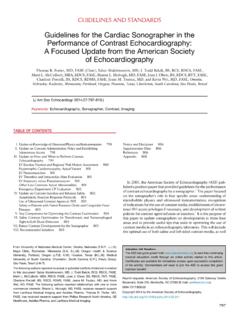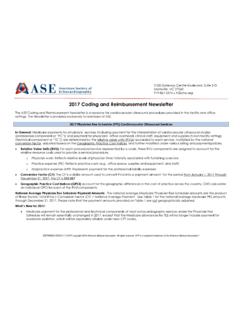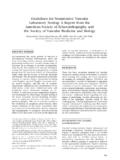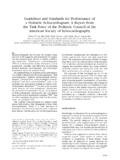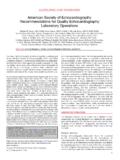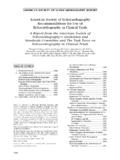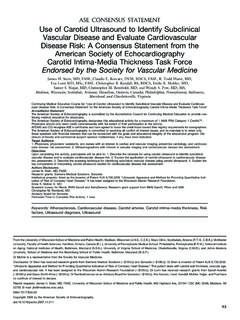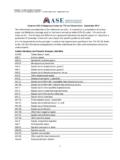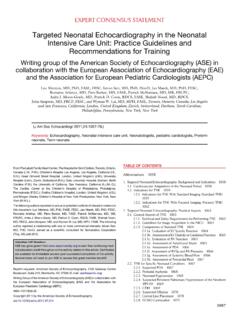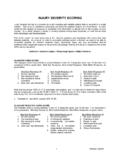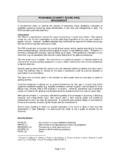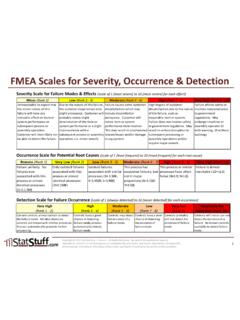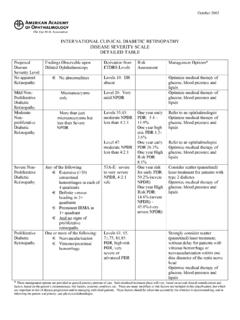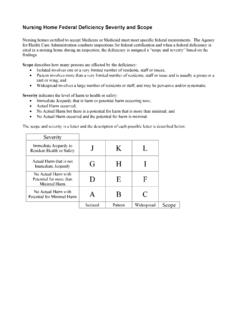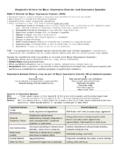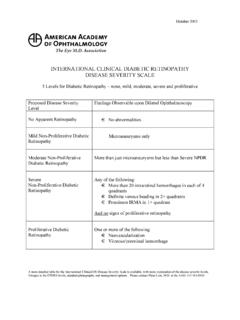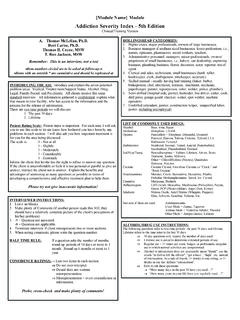Transcription of Recommendations for Evaluation of the Severity of …
1 AMERICAN SOCIETY OF ECHOCARDIOGRAPHY REPORTR ecommendations for Evaluation of theSeverity of Native Valvular Regurgitation withTwo-dimensional and DopplerEchocardiographyA report from the American Society of Echocardiography s Nomenclature and StandardsCommittee and The Task Force on Valvular Regurgitation, developed in conjunction withthe American College of Cardiology Echocardiography Committee, The Cardiac ImagingCommittee Council on Clinical Cardiology, the American Heart Association, and theEuropean Society of Cardiology Working Group on Echocardiography, represented by:William A. Zoghbi, MD, Maurice Enriquez-Sarano, MD, Elyse Foster, MD, Paul , MD, Carol D. Kraft, RDMS, Robert A. Levine, MD, Petros Nihoyannopoulos,MD, Catherine M.
2 Otto, MD, Miguel A. Quinones, MD, Harry Rakowski, MD, William , MD, Alan Waggoner, MHS, RDMS, and Neil J. Weissman, MDA. INTRODUCTIONV alvular regurgitation has long been recognized asan important cause of morbidity and the physical examination can alert theclinician to the presence of significant regurgitation,diagnostic methods are often needed to assess theseverity of valvular regurgitation and remodeling ofthe cardiac chambers in response to the volumeoverload state. Echocardiography with Doppler hasrecently emerged as the method of choice for thenon-invasive detection and Evaluation of the severityand etiology of valvular regurgitation. This docu-ment offers a critical review of echocardiographicand Doppler techniques used in the Evaluation ofvalvular regurgitation in the adult patient, and pro-vides Recommendations for the assessment of sever-ity of valvular regurgitation based on the scientificliterature and a consensus of a panel of of medical management and timing of surgicalintervention will not be addressed in this document,as these have been recently TWO-DIMENSIONAL AND DOPPLERECHOCARDIOGRAPHY IN VALVULARREGURGITATION.
3 GENERALCONSIDERATIONSV alvular regurgitation or incompetence results fromvarious etiologies including valvular degeneration,calcification, fibrosis or infection, alteration of thevalvular support apparatus or dilatation of the valveannulus. These conditions cause poor apposition ofthe valvular leaflets or cusps, and may lead toprolapse, flail, restricted leaflet motion or valvularperforation. With the advent of Doppler techniquesthat are sensitive to detection of regurgitation, trivialand physiologic valvular regurgitation- even in astructurally normal valve, is now well recognizedand is noted to occur frequently in right-sidedvalves. The following sections describe general con-siderations of the role of echocardiographic andDoppler techniques in the Evaluation of Role of Two-dimensional EchocardiographyTwo-dimensional (2D) echocardiography allows anevaluation of the valvular structure as well as theimpact of the volume overload on the cardiac cham-bers.
4 Calcifications, tethering, flail motion or vege-tations can be readily assessed, which can giveindirect clues as to the Severity of prolapse, vegetations or calcifications are notnecessarily associated with significant regurgitation,a flail leaflet almost always is. In the cases ofThese Recommendations are endorsed by the American College ofCardiology (ACC), the American Heart Association (AHA), andthe European Society of Cardiology (ESC). Representative fromthe ACC Echocardiography Committee: Elyse Foster, MD; repre-sentative from the Cardiac Imaging Committee, Council on Clin-ical Cardiology, AHA: Miguel A. Quinones, MD; representativefrom the ESC Working Group on Echocardiography: Petros Ni-hoyannopoulos, 2003 American Society of Echocardiography, Propertyof ASE.
5 Reprint of these documents, beyond single use, is prohib-ited without the prior written authorization of the ASE. Illustrativecases of valvular regurgitation are available on the Web site of theAmerican Society of Echocardiography at Address document reprint requests to theAmerican Society of Echocardiography, 1500 Sunday Drive, Suite102, Raleigh, NC 27607, phone: (919) Am Soc Echocardiogr 2003;16 2003 by the American Society of $ 0 (03)00335-3777non-diagnostic transthoracic studies, transesopha-geal echocardiography (TEE) improves the visualiza-tion of the valvular structure and delineates themechanism and Severity of duration (acute or chronic) and Severity ofvalvular regurgitation are among the most importantdeterminants of the adaptive changes that occur inthe cardiac chambers in response to the regurgitantvolume.
6 Thus, a chronic significant regurgitation isusually accompanied by an increase in size andhypertrophy of the involved cardiac chamberswhereas significant regurgitation of acute onsetfrom a condition such as endocarditis may not resultacutely in this remodeling. While cardiac chamberremodeling is not specific for the degree of regurgi-tation (ie. occurs in coronary artery disease, conges-tive cardiomyopathy etc.), its absence in the face ofchronic regurgitation should imply a milder degreeof valvular a diagnosis of significant regurgitation isestablished, serial 2D echocardiography is currentlythe method of choice for assessing the progressionof the mechanical impact of regurgitation on cardiacchamber structure and function.
7 Recommendationsfor determination of ventricular volumes and ejec-tion fraction have been previously , along with clinical Evaluation are needed foradequate timing of surgical Doppler Methods for Evaluation ofValvular RegurgitationDoppler echocardiography is the most commontechnique used for the detection and Evaluation ofseverity of valvular regurgitation. Several indexeshave been developed to assess the Severity of regur-gitation using Color Doppler, Pulsed wave (PW) andContinuous wave (CW) Doppler. Details of theDoppler techniques and the methods involved inobtaining these parameters are described in a re-cently published document from the American So-ciety of Echocardiography on quantification ofDoppler following summa-rizes the salient features of these techniques for thepurposes of Evaluation and quantitation of Color flow Doppler is widelyused for the detection of regurgitant valve technique provides visualization of the origin ofthe regurgitation jet and its width (vena contracta),the spatial orientation of the regurgitant jet area inthe receiving chamber and, in cases of significantregurgitation, flow convergence into the regurgitantorifice (Figure 1).
8 Experience has shown that atten-tion to these three components of the regurgitationlesion by color Doppler as opposed to the tradi-tional regurgitant jet area alone significantly im-proves the overall accuracy of estimation and quan-titation of the Severity of regurgitation with colorDoppler techniques. The size of the regurgitation jetby color Doppler and its temporal resolution how-ever, are significantly affected by transducer fre-quency and instrument settings such as gain, outputpower, Nyquist limit, size and depth of the , full knowledge by the sonographerand interpreting echocardiographer of these issuesis necessary for optimal image acquisition and accu-racy of of the regurgitant jet area inthe receiving chamber can provide a rapid screeningof the presence and direction of the regurgitant jetand a semi-quantitative assessment of its Severity .
9 Ingeneral, a larger area may translate into a moresignificant regurgitation. However, the sole relianceon this parameter can be quite misleading. Numer-ous technical, physiologic and anatomic factors af-fect the size of the regurgitant area and thereforealter its accuracy as an index of regurgitation size is affected by instrument factors, espe-cially pulse repetition frequency (PRF) and colorgain. Standard technique is to use a Nyquist limit(aliasing velocity) of 50-60 cm/sec, and a color gainthat just eliminates random color speckle fromnon-moving regions. Jet area is inversely propor-tional to PRF, and substantial error can be intro-duced with use of higher or lower settings than thenominal settings to which echocardiographers havebecome accustomed.
10 Regarding hemodynamic fac-tors, eccentric, wall-impinging jets appear signifi-cantly smaller than centrally directed jets of similarhemodynamic Severity , mainly because they flattenout on the wall of the receiving chamber. Theirpresence however, should also alert to the possibil-ity of structural abnormalities of the valve ( , flail, or perforation), frequently in theleaflet or cusp opposite to the direction of the , Color flow area is also influenced by flowmomentum- the product of flow rate and a jet may appear larger by increasing thedriving pressure across the valve; hence the impor-tance of measuring blood pressure for left heartlesions at the time of the echocardiographic exami-nation, particularly in the intraoperative vena contracta is the narrow-est portion of a jet that occurs at or just downstreamfrom the orifice (Figure 1).
